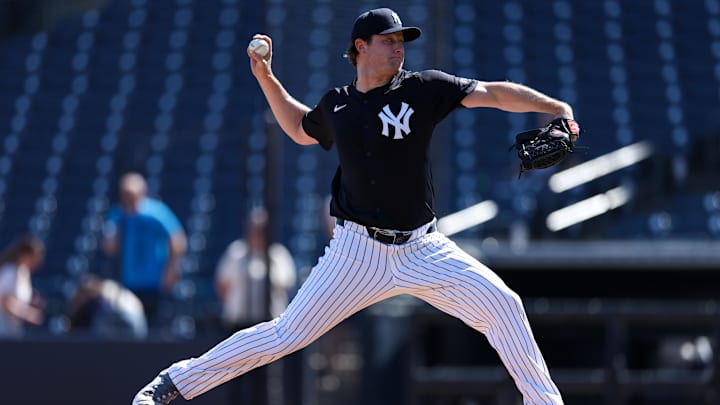Will New Arm Angle Cost New York Yankees Ace Gerrit Cole Playing Time?

In this story:
The news coming from Tampa Bay, Fla., about the possible elbow issue that New York Yankees ace Gerrit Cole is experiencing is the kind of nightmare nobody wants to hear in March.
There will be many opinions and second opinions, but a question arises: Did anything in particular change or affect Cole, or is this just another random injury caused by maximum performance?
Using the models built by pitchprofiler, there is significant evidence that Cole’s arm angle was considerably higher in Thursday's outing against the Minnesota Twins than what he averaged in 2024.
On Thursday, Cole had an average arm angle range of 48-54 degrees, where 90 degrees represents a vertical position (directly overhand) and zero degrees is horizontal (side-arm). His average arm angle in 2024 season was 42 degrees, much lower on the scale.
Research from Escamilla and Fleisig indicates that higher arm slots, such as Cole's recent 48-54 degrees, can increase elbow valgus stress, potentially linking to his current elbow concerns and diagnostic tests.
This raises an interesting question for Cole himself. Making a significant arm angle change takes extreme work to maintain consistency. While pitchers often change their arm angles on purpose, altering a natural arm slot affects everything the pitcher does.
If this was the case, it takes months to change an arm angle and stay consistent with that arm angle. The new technology that has been implemented in baseball over the past few years can mirror arm angles based upon any parameters.
It is mostly used to make sure that the different pitches in a repertoire come out of the same arm angle, otherwise hitters will pick up the pitches before they are even thrown.
Every minute aspect of the pitching delivery is broken down to the finest detail. Head position, the way you come set, where are you holding your hands when set, where is the glove pointing on each pitch, leg kick height, etc.
This all adds up to the question of why was Cole pitching with a differnt arm angle? Was there a reason? Was he trying to get more sink, possibly get on top of the ball more?
Was he getting more velocity out of this arm angle? The metrics said no.
More spin rate? Again, no.
Is it possible he was compensating for something else that was bothering him? Cole didn't indicate that when he spoke to the media on Saturday in Tampa, Fla., nor did he indicate he was adjusting his arm angle. He said he's been on an offseason program since November and has stuck with it.
In most instances, when a pitcher feels something unusual, his velocity immediately drops. This was not the case with Cole. On Thursday, his four-seam fastball averaged a velocity of 95.6 mph, aligning with his average velocity of 95.5 mph in 2024.
He did say one interesting thing about his outing on Thursday. Cole said there "too much horsepower" behind his pitches. That might explain the lack of drop in velocity.
When pitchers experience elbow pain, soreness or tightness, the arm angle typically drops to ease the stress on the elbow. The same applies to shoulder issues.
If this was a recent change to Cole’s arm slot, and he has not built up the necessary strength in the different muscles required to pitch from that angle, it could be part of what led to the elbow soreness.
It’s odd that, in this day and age, a change like this hasn’t been discussed, analyzed thoroughly and over-analyzed at this point in spring training.
Baseball as a whole hopes the tests for any tears come back negative. The game needs more pitchers like Cole and fewer lost innings for top-notch pitchers.
Recommended Articles

I am a lifelong sports fan with a deep passion for Wisconsin sports. Born and raised in Milwaukee, I have always lived in this sports-crazed city and state. With over 25 years of experience coaching baseball and football, as well as a background in business, I have gained invaluable life lessons from my time playing these sports through college. I love engaging in daily banter with fellow sports enthusiasts, approaching each game as if it were a life-or-death experience, because for many fans, it truly can feel that way. Having previously written for OnMilwaukee.com, I’ve been sitting in the bullpen, waiting for the call to once again share my old-school views on the daily sports grind.